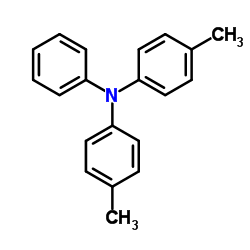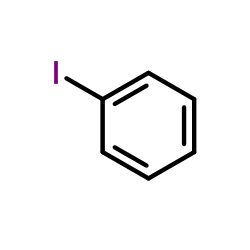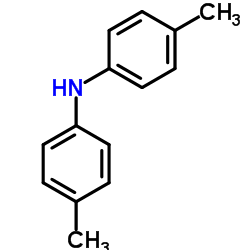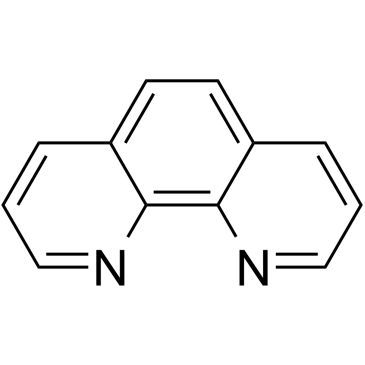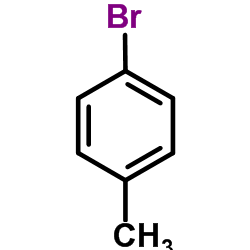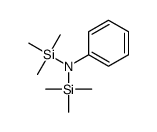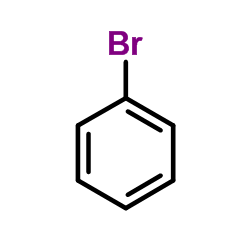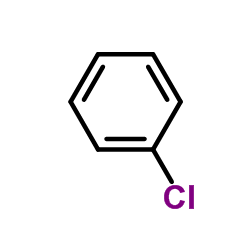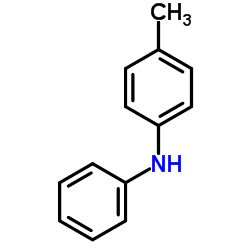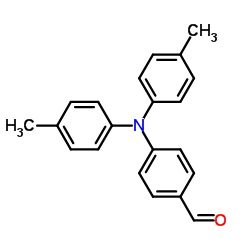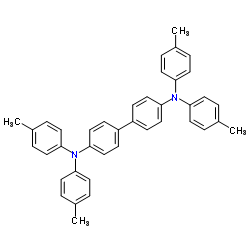20440-95-3
| 中文名 | 4,4'-二甲基三苯胺 |
|---|---|
| 英文名 | 4-methyl-N-(4-methylphenyl)-N-phenylaniline |
| 中文别名 |
N,N-二(4-甲基苯基)苯胺
4,4’-二甲基三苯胺 |
| 英文别名 |
Bis(4-Methylphenyl)Phenylamine
Benzenamine, 4-methyl-N-(4-methylphenyl)-N-phenyl- 4,4'-Dimethyltriphenylamine Phenyl(di-p-tolyl)amine N,N-Di-p-tolylaniline 4,4'-Dimethyl Triphenylamine 4,4'-Dimethyltriphenylamine (DMTPA) EINECS 243-822-7 4,4′-Dimethyltriphenylamine MFCD00145004 4,4’-Dimethyltriphenylamine 4-Methyl-N-(4-methylphenyl)-N-phenylaniline 4-methyl-N-phenyl-N-(p-tolyl)aniline |
| 密度 | 1.1±0.1 g/cm3 |
|---|---|
| 沸点 | 417.5±34.0 °C at 760 mmHg |
| 熔点 | 112°C |
| 分子式 | C20H19N |
| 分子量 | 273.372 |
| 闪点 | 183.5±22.5 °C |
| 精确质量 | 273.151764 |
| PSA | 3.24000 |
| LogP | 6.66 |
| 外观性状 | 白色粉末 |
| 蒸汽压 | 0.0±1.0 mmHg at 25°C |
| 折射率 | 1.627 |
| 储存条件 | 储存在阴凉,干燥的地方 |
| 稳定性 | 常温常压下稳定,避免接触强氧化剂 |
| 分子结构 | 1、 摩尔折射率:89.74 2、 摩尔体积(m3/mol):253.1 3、 等张比容(90.2K):653.4 4、 表面张力(dyne/cm):44.4 5、 极化率(10-24cm3):35.57 |
| 计算化学 | 1.疏水参数计算参考值(XlogP):无 2.氢键供体数量:0 3.氢键受体数量:1 4.可旋转化学键数量:3 5.互变异构体数量:无 6.拓扑分子极性表面积3.2 7.重原子数量:21 8.表面电荷:0 9.复杂度:269 10.同位素原子数量:0 11.确定原子立构中心数量:0 12.不确定原子立构中心数量:0 13.确定化学键立构中心数量:0 14.不确定化学键立构中心数量:0 15.共价键单元数量:1 |
| 更多 | 1.性状:未确定 2.密度(g/mL,25/4℃):未确定 3.相对蒸汽密度(g/mL,空气=1):未确定 4.熔点(ºC):112 5.沸点(ºC,常压):未确定 6.沸点(ºC,5.2kPa):未确定 7.折射率:未确定 8.闪点(ºC):未确定 9.比旋光度(º):未确定 10.自燃点或引燃温度(ºC):未确定 11.蒸气压(kPa,25ºC):未确定 12.饱和蒸气压(kPa,60ºC):未确定 13.燃烧热(KJ/mol):未确定 14.临界温度(ºC):未确定 15.临界压力(KPa):未确定 16.油水(辛醇/水)分配系数的对数值:未确定 17.爆炸上限(%,V/V):未确定 18.爆炸下限(%,V/V):未确定 19.溶解性:未确定 |
Synonym: Section 2 - COMPOSITION, INFORMATION ON INGREDIENTS
Risk Phrases: None Listed. Section 3 - HAZARDS IDENTIFICATION EMERGENCY OVERVIEW
The toxicological properties of this material have not been fully investigated. Potential Health Effects Eye: May cause eye irritation. The toxicological properties of this material have not been fully investigated. Skin: May cause skin irritation. The toxicological properties of this material have not been fully investigated. Ingestion: May cause gastrointestinal irritation with nausea, vomiting and diarrhea. The toxicological properties of this substance have not been fully investigated. Inhalation: May cause respiratory tract irritation. The toxicological properties of this substance have not been fully investigated. Chronic: Not available. Section 4 - FIRST AID MEASURES Eyes: Flush eyes with plenty of water for at least 15 minutes, occasionally lifting the upper and lower eyelids. Get medical aid immediately. Skin: Get medical aid. Flush skin with plenty of water for at least 15 minutes while removing contaminated clothing and shoes. Wash clothing before reuse. Ingestion: If victim is conscious and alert, give 2-4 cupfuls of milk or water. Never give anything by mouth to an unconscious person. Get medical aid immediately. Inhalation: Remove from exposure and move to fresh air immediately. If not breathing, give artificial respiration. If breathing is difficult, give oxygen. Get medical aid. Notes to Physician: Section 5 - FIRE FIGHTING MEASURES General Information: As in any fire, wear a self-contained breathing apparatus in pressure-demand, MSHA/NIOSH (approved or equivalent), and full protective gear. Dusts at sufficient concentrations can form explosive mixtures with air. During a fire, irritating and highly toxic gases may be generated by thermal decomposition or combustion. Extinguishing Media: Use agent most appropriate to extinguish fire. Use water spray, dry chemical, carbon dioxide, or appropriate foam. Section 6 - ACCIDENTAL RELEASE MEASURES General Information: Use proper personal protective equipment as indicated in Section 8. Spills/Leaks: Clean up spills immediately, observing precautions in the Protective Equipment section. Sweep up or absorb material, then place into a suitable clean, dry, closed container for disposal. Provide ventilation. Section 7 - HANDLING and STORAGE Handling: Wash thoroughly after handling. Remove contaminated clothing and wash before reuse. Use only in a well-ventilated area. Avoid contact with eyes, skin, and clothing. Avoid ingestion and inhalation. Storage: Keep container closed when not in use. Store in a cool, dry, well-ventilated area away from incompatible substances. Section 8 - EXPOSURE CONTROLS, PERSONAL PROTECTION Engineering Controls: Use adequate ventilation to keep airborne concentrations low. Exposure Limits CAS# 20440-95-3: Personal Protective Equipment Eyes: Wear appropriate protective eyeglasses or chemical safety goggles as described by OSHA's eye and face protection regulations in 29 CFR 1910.133 or European Standard EN166. Skin: Wear appropriate protective gloves to prevent skin exposure. Clothing: Wear appropriate protective clothing to prevent skin exposure. Respirators: Follow the OSHA respirator regulations found in 29 CFR 1910.134 or European Standard EN 149. Use a NIOSH/MSHA or European Standard EN 149 approved respirator if exposure limits are exceeded or if irritation or other symptoms are experienced. Section 9 - PHYSICAL AND CHEMICAL PROPERTIES Physical State: Powder Color: white Odor: Not available. pH: Not available. Vapor Pressure: Negligible. Viscosity: Not available. Boiling Point: Not available. Freezing/Melting Point: 112 deg C Autoignition Temperature: Not available. Flash Point: Not available. Explosion Limits, lower: Not available. Explosion Limits, upper: Not available. Decomposition Temperature: Solubility in water: Negligible. Specific Gravity/Density: Molecular Formula: C20H19N Molecular Weight: 273.38 Section 10 - STABILITY AND REACTIVITY Chemical Stability: Stable under normal temperatures and pressures. Conditions to Avoid: Incompatible materials, strong oxidants. Incompatibilities with Other Materials: Strong oxidizing agents. Hazardous Decomposition Products: Nitrogen oxides, carbon monoxide, irritating and toxic fumes and gases, carbon dioxide. Hazardous Polymerization: Will not occur. Section 11 - TOXICOLOGICAL INFORMATION RTECS#: CAS# 20440-95-3 unlisted. LD50/LC50: Not available. Carcinogenicity: N-Phenyl Di-P-Tolylamine - Not listed by ACGIH, IARC, or NTP. Section 12 - ECOLOGICAL INFORMATION Section 13 - DISPOSAL CONSIDERATIONS Dispose of in a manner consistent with federal, state, and local regulations. Section 14 - TRANSPORT INFORMATION IATA Not regulated as a hazardous material. IMO Not regulated as a hazardous material. RID/ADR Not regulated as a hazardous material. Section 15 - REGULATORY INFORMATION European/International Regulations European Labeling in Accordance with EC Directives Hazard Symbols: Not available. Risk Phrases: Safety Phrases: S 24/25 Avoid contact with skin and eyes. WGK (Water Danger/Protection) CAS# 20440-95-3: No information available. Canada CAS# 20440-95-3 is listed on Canada's NDSL List. CAS# 20440-95-3 is not listed on Canada's Ingredient Disclosure List. US FEDERAL TSCA CAS# 20440-95-3 is listed on the TSCA inventory. SECTION 16 - ADDITIONAL INFORMATION N/A |
| 危害码 (欧洲) | T+ |
|---|---|
| 风险声明 (欧洲) | R36/37/38:Irritating to eyes, respiratory system and skin . |
| 安全声明 (欧洲) | S26-S36 |
| 海关编码 | 2921440000 |
| 上游产品 9 | |
|---|---|
| 下游产品 3 | |
| 海关编码 | 2921440000 |
|---|---|
| 中文概述 | 2921440000. 二苯胺及其衍生物以及它们的盐. 增值税率:17.0%. 退税率:17.0%. 监管条件:无. 最惠国关税:6.5%. 普通关税:30.0% |
| 申报要素 | 品名, 成分含量, 用途 |
| Summary | 2921440000. diphenylamine and its derivatives; salts thereof. VAT:17.0%. Tax rebate rate:17.0%. . MFN tariff:6.5%. General tariff:30.0% |


